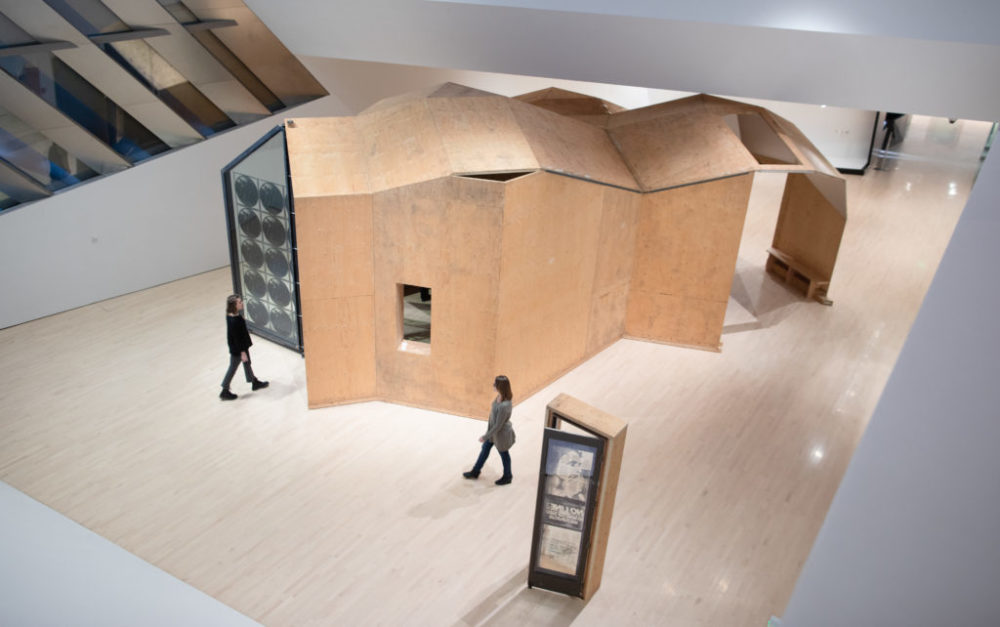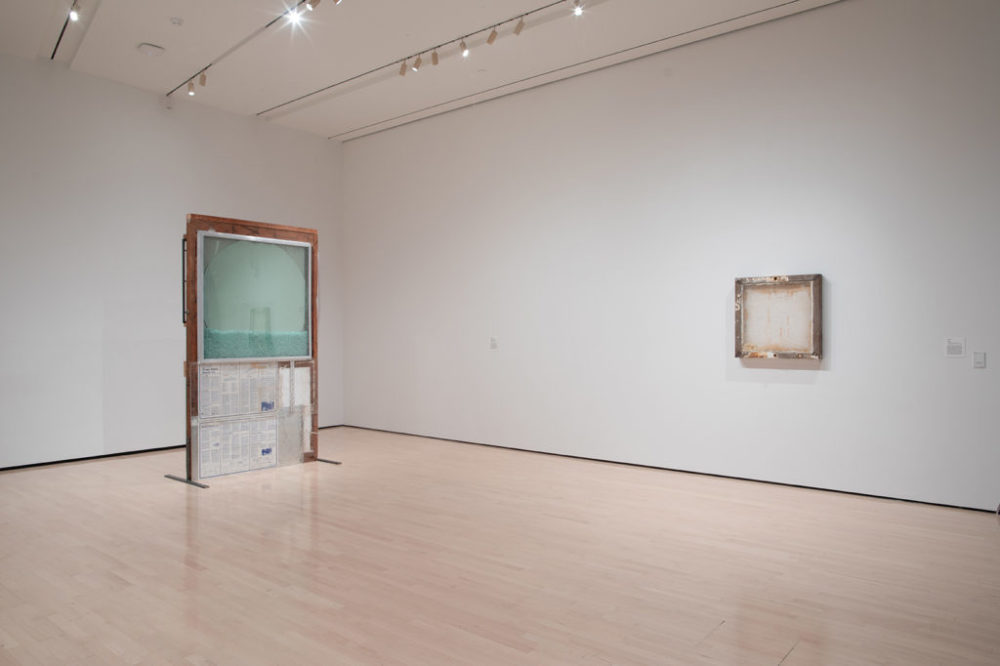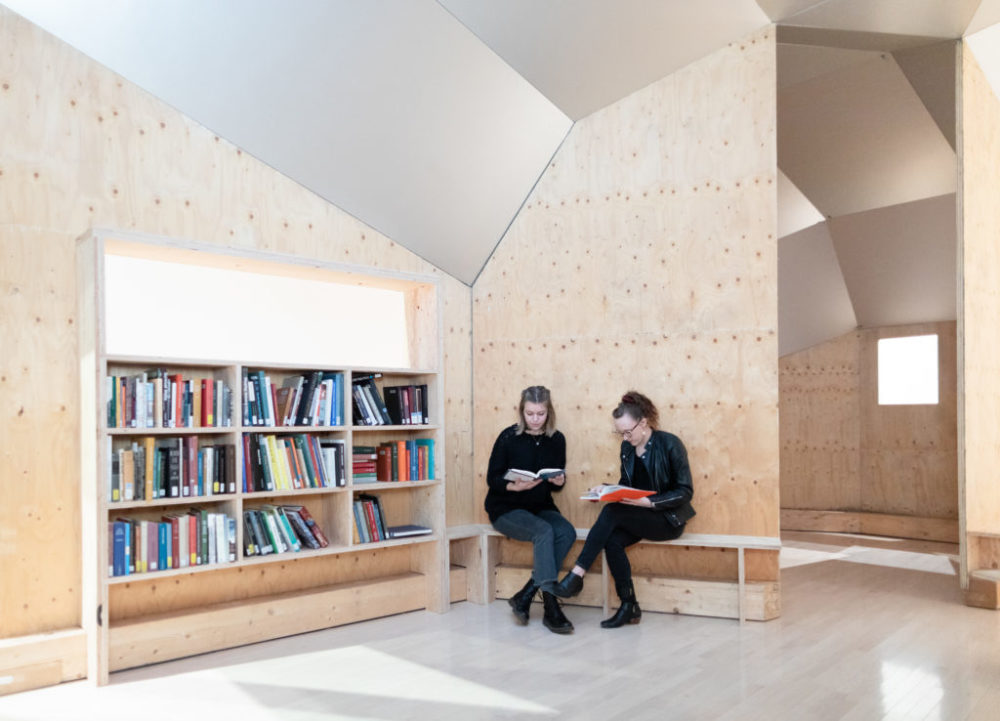- Source: THE SEEN
- Author: GABRIELLE WELSH
- Date: APRIL 18, 2019
- Format: PRINT
Water School: Oscar Tuazon

Oscar Tuazon: Water School, installation view at the Eli and Edythe Broad Art Museum at Michigan State University, 2019. Photo: Eat Pomegranate Photography.
“East Lansing, huh? I have an uncle out there,” the taxi driver tells me en route to Union Station. I am making the trip to the small town nestled halfway between Grand Rapids, MI and Detroit. “Not much to do.”
This seems indicative of all Chicagoans who I told of my travels; a general nod to a distant relative who attended Michigan State University in the last thirty years, or a place once stopped at for lunch when the end goal was another place. The town is unassuming and quaint, similar to nearly every college town I have visited, with a beautiful campus and a massive student body of 50,000. But the reason I travelled from Chicago to a much more comforting snow-stricken East Lansing was for their contemporary art museum, the MSU Broad, which has surprisingly placed itself as a world-class institution.
Their lead exhibition currently on view, entitled Oscar Tuazon: Water School, enacts a community-based educational model within the museum, which surrounds the LA-based artist’s practice. A large, light-wood honeycomb structure entitled Zome Alloy (2016)—shaped after American inventor and pioneer of passive solar technology Steve Baer’s early waste-free Domehomes— overtakes the gallery, placing importance on the ability of architecture to create and foster space, and houses the ‘school’ within which public programming occurs. The adjacent galleries of the museum display additional sculptural works by Tuazon, most with some utilitarian use, that the artist pulls influence from 1960s–70s countercultural icons, namely Baer, Buckminster Fuller, and Robert Frank, among others. Copies of the Whole Earth Catalogue line display cases next to an early copy of Baer’s Dome Cookbook (1969)—if anything, these intangible objects draw a conceptual link to the long history of radical and countercultural publishing. Through these influences, Tuazon draws together his own sculptural and artistic practice, while simultaneously revealing a long lineage of environmentalists-turned-inventors, and vice-versa. The Alloy first found its home at the Art Basel Messeplatz, as part of the fair’s outside installation program, yet was unoccupied, whereas in its current existence at the MSU Broad, the piece is positioned as a library with seating—allowing instead for a further investigation into the histories of land rights and water. In this state, the work is more readily able to explore the cultural ways in which water bridges communities, but more importantly the often (quite deliberately) unseen political history that water and its infrastructure has.
The installation at the MSU Broad is one of several iterations of the Water School, which at its core seeks to connect vast distances through informal learning and conversation surrounding these issues through a metaphorical proposal that investigates the ways in which a river connects communities. With satellite schools in both Minnesota and California, Tuazon’s Water School here feels especially timely with the ongoing water crisis in Flint, Michigan, less than an hour’s drive away; prints done by the artist line the wall and stock the small museum store, tracing maps of where clean water runs in the state.
One gets the feeling that both the university and museum are generally concerned with environmental efforts—not only do the parking garages turned solar farms give some indication of this, but the view from the MSU Broad looks directly out towards a Moosejaw, a retailer specializing in outdoor wear, and around the corner lies a Birkenstock store. Not quite belonging to a hippie classification, as that era has passed, Water School instead brings together the types that are concerned with new-wave environmentalism. The archival material included within the exhibition sparks an element of nostalgia for a time that viewers of a younger generation have never experienced—nodding to the massive popularity of present archival practices in contemporary art, the programming surrounding Water School is perhaps the most interesting aspect of this exhibition.

Oscar Tuazon: Water School, installation view at the Eli and Edythe Broad Art Museum at Michigan State University, 2019. Photo: Eat Pomegranate Photography.
Water School convenes twice a month, with weekend events interspersed, and the library within always open during the museum’s hours. An important element of the exhibition is also an eleven-page bibliography available on the website—the curated selection includes titles close to my heart (that I was surprised to find within a museum), such as Mumia Abu- Jamal’s Writing on the Wall: Selected Prison Writings, Alexander Vasudevan’s The Autonomous City: A History of Urban Squatting, and the ever-popular A People’s History of the United States by Howard Zinn. If anything, the library is a nice change from the world of artist books and catalogues advertised in nearly every art museum. To give a taste of what the school is like, its first session included an Anishinaabe blessing, acknowledging whose land the Broad sits upon; a sculpture-making workshop utilizing recycled materials; a breakout session with guest artists, educators, architects, and activists to discuss ‘how different sociopolitical backgrounds affect one’s relationship to sustainability,’ mirroring the ways in which grassroots organizing convenes; and a reading of a poem by Jessyca Mathews, an English teacher in Flint, MI. The weekly sessions range from small discussions to writing workshops.
As curator Steven L. Bridges explains of the focus of the museum’s outreach, “Some of the core values at play here are notions such as reciprocal learning and making a concerted move away from more authorial and authoritarian modes of address. Certainly, the artist, the curator, and the museum educator all have knowledge to share, but it is not the end-all be-all. The bottom line is to try and create a space where people come together and share the knowledge they have—a space in which different forms of understanding and learning are valued.”
In the most positive sense, these community outreach and engagement initiatives work to move the museum away from the rigidness of white-walls and ever-present guards towards the ability of art and learning to incite change. On the other hand, I am quite hesitant towards the art museum as a space for organizing—not only are these spaces entrenched in the capital that radical politics are often positioned against, but the popularity of the museum-turned-activist indicates the marketability interwoven with ‘activist art.’ All of this said, Water School remains most compelling use of a contemporary art museum as a space for political dialogue I have yet to see. Guides walk through the space making it clear that should viewers have any questions, they would happily answer—so many conversations were happening around me, I was delightfully surprised by the interactions.

Oscar Tuazon: Water School, installation view at the Eli and Edythe Broad Art Museum at Michigan State University, 2019. Photo: Eat Pomegranate Photography.
My lodging was perhaps the best indicator that there may be some disconnect between greater Michigan culture and the community-oriented learning that the Water School presents. I unintentionally stayed in the ‘Indian Summer’ suite at a local bed & breakfast. Various totem poles and troubling caricatures of the ‘universal’ Native American man à la the white imaginary surrounded my bed. The reading list and Anishinaabe blessing pinned on the wall of the School burned in my mind as I fell asleep knowing the same museum that housed the library facilitated my stay in this room.
But I think this is the optimism that Water School and its programming enacts, one where learning and community-building is key to solidarity; with that I agree. That perhaps through alternative pedagogy, an environmentalism will come—one that acknowledges indigenous land rights and the destructive nature of colonial capital. One that engages young people to stop the destruction that the wealthy few have put in motion. The question is how to move it from the museum into the unsettled space beyond its walls.

